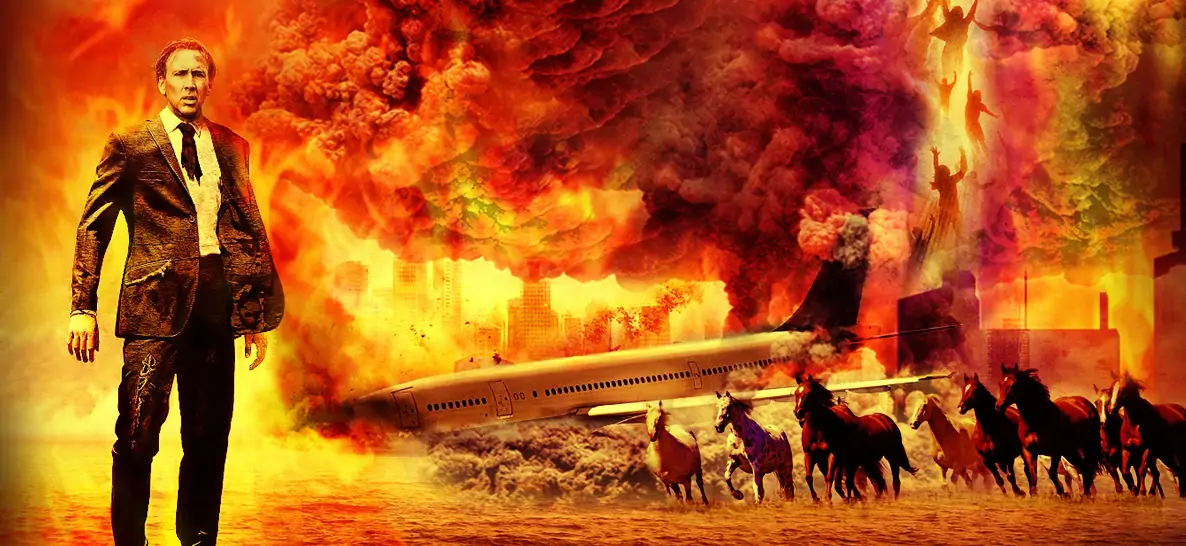
This weekend, the latest in a long series of Christian apocalypse films hits theaters nationwide, as Nicolas Cage leads the charge in yet another adaptation of the Left Behind novels. The early reviews have not been altogether kind (We’ll be posting our own review later today).
The film follows a decades-long trend of Christians making mid-budget action movies based on the end of the world, using the same formula that’s been repeated onscreen for the last 40 years: A Godless society is ushered into the end times, leading to an apocalyptic showdown foretold by the book of Revelation.
And though many Christians are familiar with the latest movie’s source material (the 16-part Left Behind series sold a mind-blowing 65 million copies), many remain blissfully unaware of the (insane) forgotten film that started it all.
In 1970, an exploitation filmmaker, magician, pilot, and roller derby entrepreneur named Ron Ormond walked away from his second nearly fatal airplane accident in just two years. The grindhouse auteur—whose credits include The Monster and the Stripper and Untamed Mistress (about the search through “the jungle for a woman who has been captured by a tribe of murderous gorillas”)—decided that surviving the last plane crash should serve as a wake-up call and would soon commit to using his filmmaking talents for God.
Ormond, who’d written, directed and produced a collection of low-budget westerns and horror flicks, determined that he needed a partner in his new religious endeavor. A southern fire-and-brimstone preacher named Estus Pirkle proved to be the perfect companion to utilize the shock and power of exploitation ‘70s cinema to drive people to the alter.
Their first project together was based on one of Pirkle’s favorite terror-inducing sermons, in which he warns people that because of America’s moral decline (into unthinkable anti-fundamentalist evils like social dancing, drive-in theaters and wearing make-up) God’s judgment was imminent. And because this was 1971, at the height of the Cold War, the judgment would obviously be in the form of a Communist takeover of America. (A remarkably easy land invasion of the United States by Communists is also a primary plot point in Chuck Norris’ 1985 action effort, Invasion U.S.A. You can guess how that one ended. Weirdly, in both films, Communists simply show up and begin their takeover with little resistance. In Ormond’s movie, their troops actually just wander the countryside on horseback rounding up church-goers.)
The resulting film is the rather grandly titled If Footmen Tire You, What Will Horses Do? (Warning: The film is on YouTube, but before you go watching it, you may want to read the rest of this article so you are totally clear on what you’re in for. There are some genuinely disturbing things you can’t unsee, no matter how badly you may later want to.)
In one of the first scenes, a newscaster appears on television warning American families that the Communists have invaded, killing the President, high-ranking officials and “several governors.” The rest of the movie disturbingly depicts an increasingly strange series of atrocities that comrades inflict on Christians—bamboo shoots into people’s ears, mass executions, the violation of Christian housewives and of course, because this is a film about the tribulation (or at least God’s judgment), government-sanctioned beheadings (a future staple of the tribulation genre).
Ironically, though Pirkle’s sermon constantly warns the audience about God’s disdain for the violence on TV and movies, the movie itself contains heaps of graphic, torture porn-y violence. It’s like Eli Roth making A Thief In the Night on a shoestring budget. The body count easily goes into the hundreds.
Although If Footmen Tire You, What Will Horses Do? isn’t exactly about the book of Revelation—though Pirkle alludes to the book’s prophetic metaphors—it’s definitely about the end of the world.
While Ormond would go on to create a handful of other graphic “Christian” movies—The Burning Hell, The Sword of the Lord, The Grim Reaper, etc.—it was Footmen that serves as the first major effort in the “End of the World” genre that has captivated religious filmmakers ever sense.
A year after its release, in 1972, another Hollywood horror producer, Russell S. Doughten, the producer and director of the 1958 cult classic horror movie The Blob, released his first in an epic 4-part series of films that spanned more than decade. At the time, the Thief in the Night series was one of the most ambitious film projects ever attempted. Like Footmen, most of Thief in the Night is utterly terrifying. The four films, Thief in the Night, A Distant Thunder, Image of the Beast, and The Prodigal (each would make for killer names for metal albums, am I right?) tell a continuous story of a group of rapture survivors who battle the Antichrist’s forces throughout the tribulation as Doughten literally interprets Revelation. Also like Footmen, there are graphic executions at the hands of psychotic government enforcers.
The series has become a cult hit in evangelicalism (that, unlike Footmen, is still accepted by some segments of Christian audiences), and marked an interesting convergence of Hollywood-style horror, large-scale filmmaking, big-screen action and an obvious agenda to get people scared back to church.
About 10 years after the final film in the Thief in the Night series wrapped, two Christian writers, Jerry Jenkins and Tim LaHaye, released their first book in what would be a whopping 16-part series of novels also about a group of rapture survivors who fight the forces of Antichrist throughout the tribulation.
Cloud Ten Pictures—the studio that eventually found success with the first Left Behind adaptations—was not new to the end-times entertainment game when they made the Kirk Cameron trilogy. They are behind a series of four films in their own Apocalypse franchise, essentially exploring the same source material, with different B-list actors (Gary Busey, Corbin Bernsen, Mr. T and Howie Mandel all have significant roles in the movies.)
Thanks to his current status as Hollywood’s wildest wild card, Nicolas Cage’s latest contribution to the genre may end up being the most widely-seen Christian apocalypse thriller ever to come out of Christendom, but it’s the long-forgotten work of Ron Ormond that may have actually started the genre that filmgoers are still subjected to to this day.
I wish we’d all been ready.






















